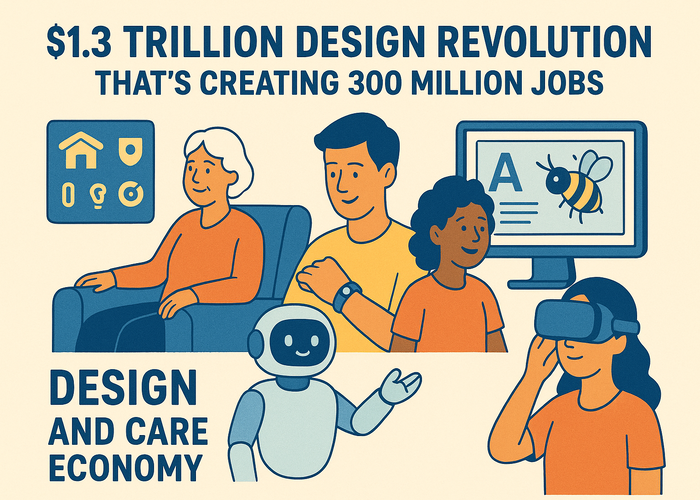The $1.3 Trillion Design Revolution That's Creating 300 Million Jobs

A simple colour change in a smartphone app prevents a diabetic grandmother from missing her insulin dose. A thoughtfully designed chair helps a stroke survivor regain independence. A playful learning interface transforms how children with autism communicate with the world. This isn't science fiction—it's happening right now, and it's creating one of the most exciting career frontiers of our time.
While everyone's talking about AI and automation displacing jobs, there's a quieter revolution brewing that's doing the exact opposite. The care economy is experiencing explosive growth, and it's hungry for creative minds who understand that good design isn't just about making things look pretty—it's about making life better.
The Numbers Tell a Compelling Story
By 2050, our world will look dramatically different. The World Health Organization predicts we'll have 2.1 billion people over 60—that's more than double today's numbers. But here's what makes this fascinating rather than frightening: this demographic shift is colliding with the most innovative period in human history.
The result? A perfect storm of opportunity.
The World Economic Forum recently revealed that investing $1.3 trillion in the care economy could generate nearly 300 million jobs by 2035. That's not just any jobs—these are roles that blend cutting-edge technology with human compassion, where your creative skills could literally save lives.
Beyond Traditional Boundaries
Forget everything you thought you knew about healthcare and eldercare. This isn't about sterile hospitals and boring medical devices anymore. Today's care economy is a vibrant ecosystem where designers are crafting:
- Smart homes that intuitively respond to aging bodies, making independence possible well into someone's golden years
- Wearable devices that don't just track steps but predict health crises before they happen
- Educational platforms that turn learning challenges into engaging adventures for children with special needs
- Virtual reality therapy sessions that help trauma survivors heal in safe, controlled environments
- AI-powered companions that provide emotional support without replacing human connection
The Human-centred Design Advantage
What makes this revolution different from previous tech booms is its foundation in empathy. Human-centred design has moved from buzzword to business imperative because, in the care economy, understanding people isn't optional—it's everything.
This approach creates a fascinating multiplier effect. When you design with genuine empathy, you don't just solve one problem—you often discover solutions that benefit entire communities.
- A wheelchair-accessible design makes spaces better for everyone
- A simplified medication reminder helps not just elderly patients but busy parents managing family health
Your Creative Superpowers, Amplified
If you've ever felt torn between pursuing creative fulfilment and making a meaningful impact, the care economy offers an unprecedented synthesis. Your aesthetic sensibilities become tools for dignity. Your user experience expertise becomes a pathway to independence. Your visual communication skills become bridges connecting isolated individuals to their communities.
The most exciting part? We're still in the early stages. The intersection of design, technology, and care is creating entirely new specializations that didn't exist five years ago:
- Therapeutic game designers
- Accessible technology consultants
- Age-tech user researchers
- Senior-focused service designers
A Future Worth Designing
This isn't just about individual career opportunities—it's about participating in a fundamental shift toward a more compassionate economy. As automation handles routine tasks, human creativity and empathy become our most valuable currencies.
The care economy represents something remarkable: a sector where growth comes from nurturing rather than extracting, where success is measured not just in profits but in lives improved, independence restored, and dignity preserved.
The question isn't whether this transformation will happen—it's already underway. The real question is whether you'll be part of shaping it.
Are you ready to discover how your creative talents could become someone's lifeline?
Written by,
Mr. Abhilash B.S.
Assistant Professor & HOD in Charge, Presidency School of Design













 Rajanukunte, Yelahanka, Bengaluru, Karnataka, Pin: 560119, India
Rajanukunte, Yelahanka, Bengaluru, Karnataka, Pin: 560119, India
 +91 9022092222
+91 9022092222